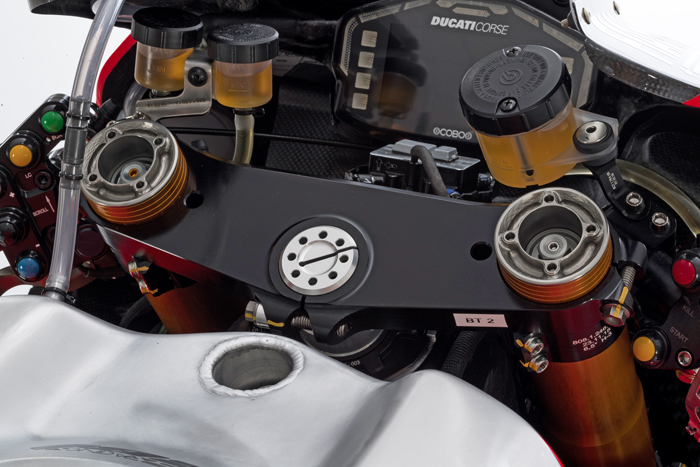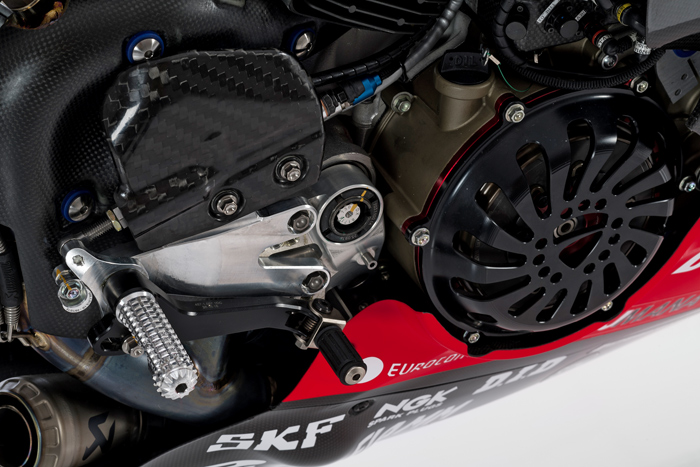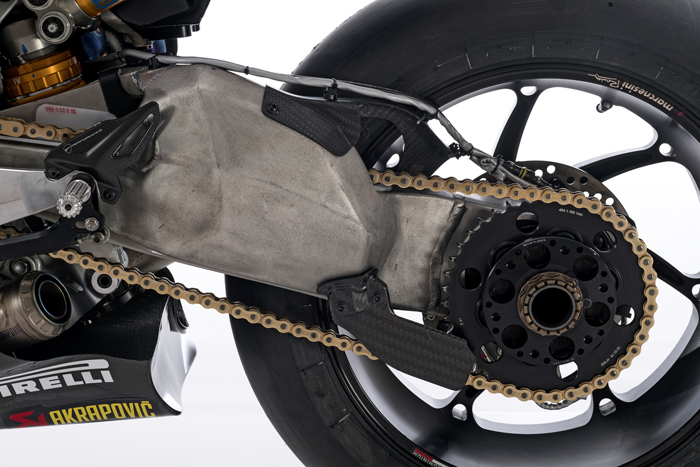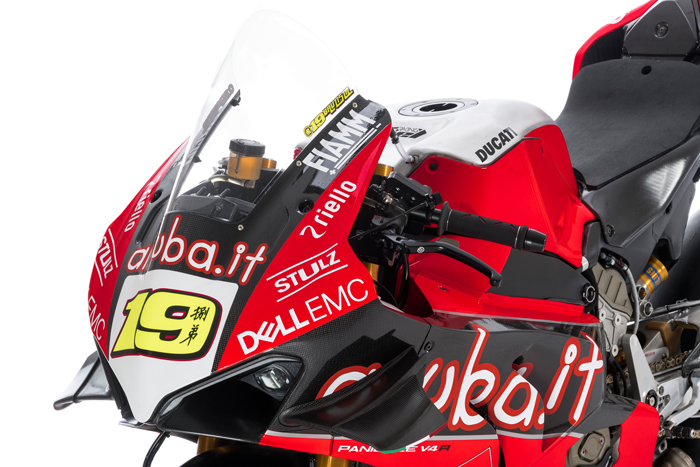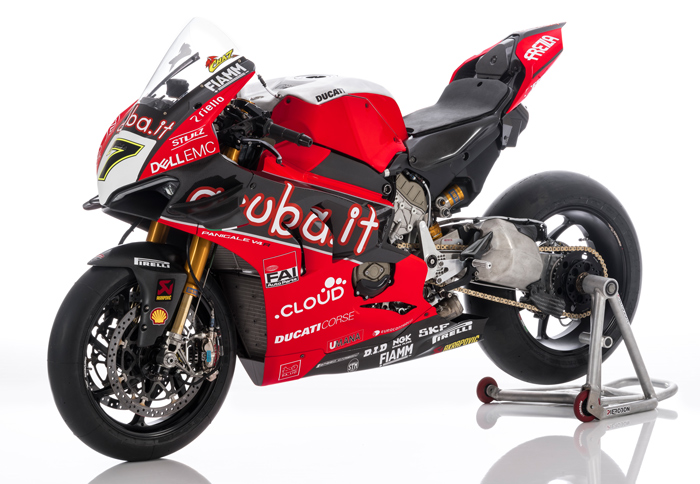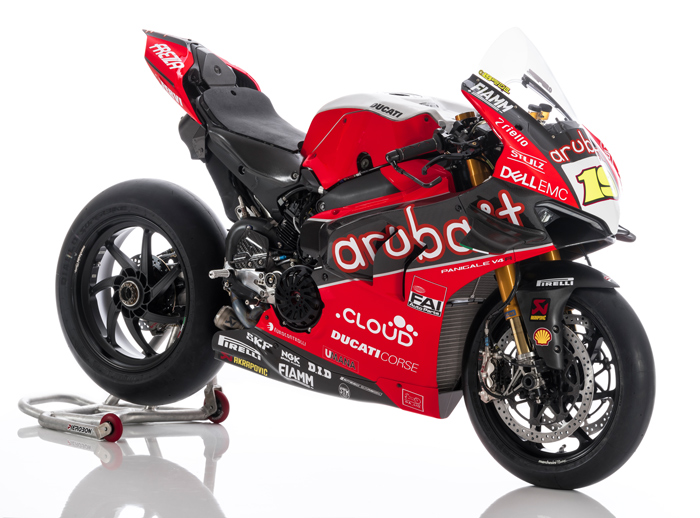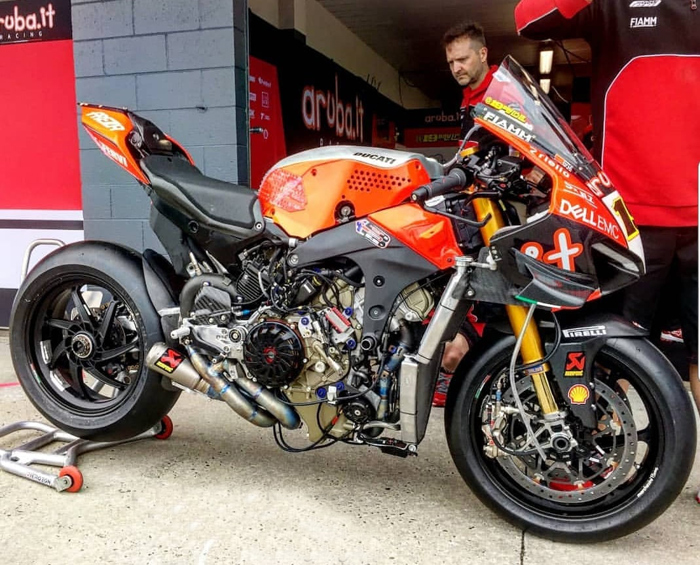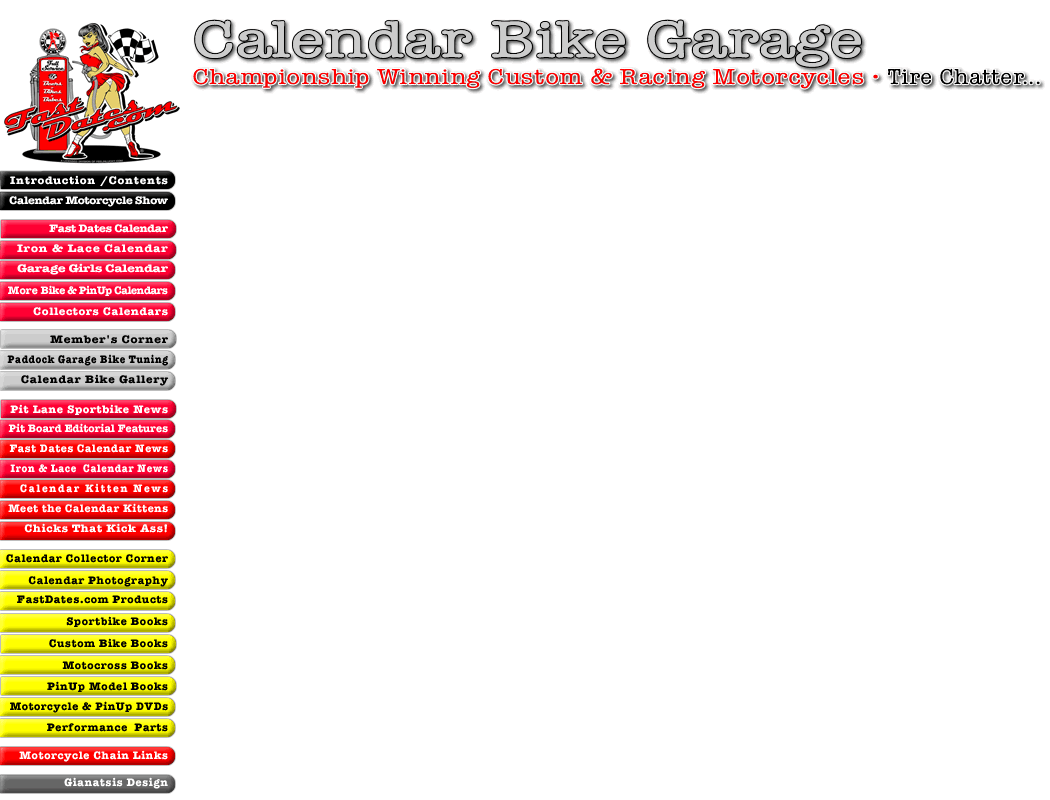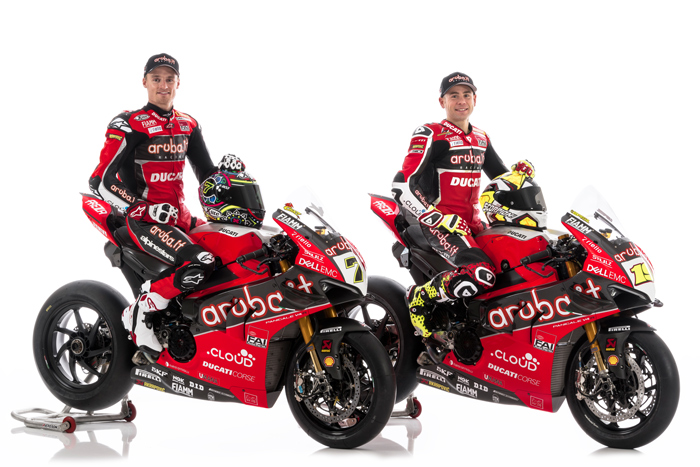 2019 Ducati Corse World Superbike team riders Chaz Davies(7) and Álvaro Bautista (19). 2019 Ducati Corse World Superbike team riders Chaz Davies(7) and Álvaro Bautista (19).
Bologna, Italy, March 1st 2019 - The Panigale V4 RS 19 is the Team Ducati Corse race track version(designation "S" with 19 denoting the year 2019) of the limited production street legal V4R, modified for use in the 2019 SBK World Superbike Championship and various National Championship like the BSC British Superbike ant Italian Championships.
Compared to previous R versions, the Panigale V4 R is now even more specialised and bristles with technology taken directly from MotoGP. The modifications extend far beyond the engine and suspension set-up: they also include the fairing, designed and developed by Ducati Corse in close collaboration with the Ducati Style Centre to improve aerodynamic efficiency. The new fairing also incorporates the aero foil appendages developed for the MotoGP prototypes. Made of carbon fibre, they increase stability throughout the ride, to allow for reduced reliance on electronic controls, boosting confidence for the pinnacle of rider performance.
The Panigale V4 R is, to all intents and purposes, a road-legal WSBK category competition bike and constitutes the technical foundation for the official Ducati Superbikes that will compete in the World Championship as from the 2019 season .FIM World Superbike Rules require that a homologation bike, on which a WSBK V4RS race bike is based on, sell for no more than USD $40,000. So Ducati now retails the more expensive to produce V4R19 at $40,000 (the previous V2R15 retailed at $36,000), not including the Akrapovic Titanium full race exhaust system which is an additional $5,100.
The price of a World Superbike spec V4RS19 built by hand in the Ducati Corse race shop will set you you back more than twice that price, as the production based bike is meticulously rebuilt from the ground up. The RS engine can possibly get higher compression pistons, different camshafts, and certainly a different race clutch. Because the V4 Stradale is based on the Ducati MotoGP bike's engine, in theory it can be built and tuned in race spec to make about the same 280hp near 18,000rpm.
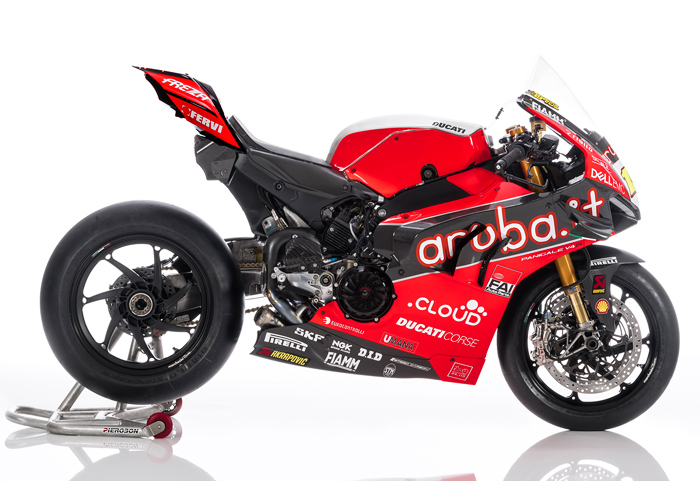
The V4RS19 SBK with higher spec Marchesini forged and drilled race wheels, exposed dry cutch
But Dorna the last few years has been capping WSBK peak horsepower at 220hp so their production based series doesn't match the pure performance limelight of their MotoGP machines. And as we're see the last 2 years, WSBK now balances the race win performance of the different team bikes with mandatory RPM limits. As a road bike the Ducati V4 R redlines at 16,000 rpm, and presents peak power at 15,250 rpm, so after the FIM has performed its calculations it is now allowed to rev to 16,350 rpm, in full World SBK trim.
The production V4R's stock power output is 221 hp (162 kW) of power at 15,250 rpm (EU homologation values) with the stock street exhaust, and adding the Akrapovic Titanium Full race Exhaust System raises the dyno power to 234 hp (172 kW) at 15,500 rpm. So we can guess a Ducati V4RS Corse SBK engine with higher compression thanks to race gas, maybe hotter cams, and a higher 16,300rpm rev limit is probably making a lot more than that.
The next most rev-happy World SBK machinery comes in below the 15,000 rpm barrier, so there is a huge difference for Ducati to exploit if they can get their engineering right. The previous Championship dominating Kawasaki Ninja ZX-10RR, although mostly new just because of its higher revving 2019 engine design. As a road bike it has 600 more rpm compared to the previous model, but in World SBK trim, it has ‘just’ 500 rpm more. It will have a maximum of 14,600 rpm starting the 2019 season.
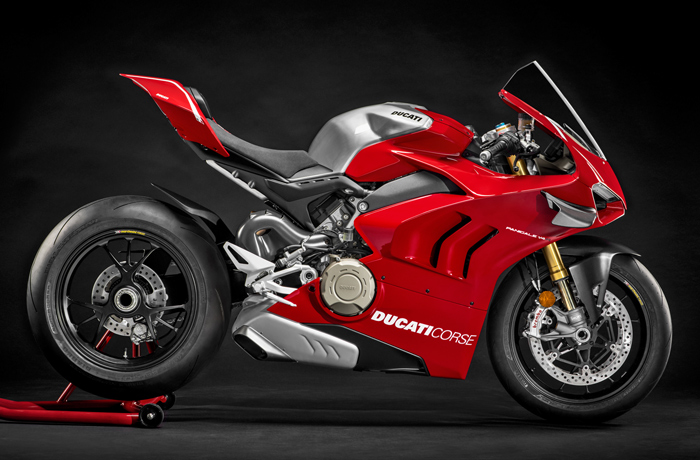
The production V4R19 for comparison, with lower spec Marchesini forged street wheels, covered dry cutch.
As for the Electronics, there's
an all new race CPU and electronics with suspension travel monitors and GPS track location so engineers can tune the engine's power characters and how it responds in different corners and straights of a particular race track. And of course the street bike instrument panel is replaced with a pure race console. And switch buttons on the handlebar to change engine power programs, along with a pit speed limiter.
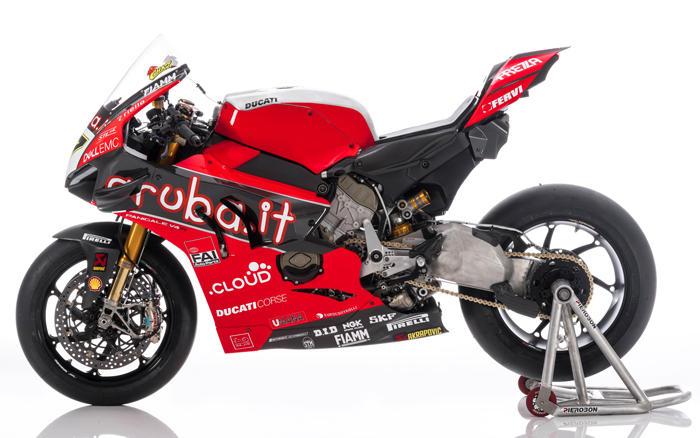 Above: The V4RS19 has a different swingarm, and a fuel tank extending lower beside the rear shock. Above: The V4RS19 has a different swingarm, and a fuel tank extending lower beside the rear shock.
In the RS chassis department, a lot of changes take place. Higher race spec Ohlins front and rear suspension is used, with the front forks capped by rules to cost no more than $10,000. You note how the lower brake caliper holders on the forks are CNC machined to look like they will snap off with just a firm application of the MotoGP spec Bembo.
There is a special beefier swingarm mounting bracket bolting to the engine for less flex, with the drive chain running behind it, as opposed to the production brake on the street V4 where the drive chain runs outside it. And the swingarm pivot bolt has a more precise calibrated excentric adjuster for tuning drive out of corners. And the rear swingarm is quite different from production, being less bulky and lighter, with possibly a longer length.
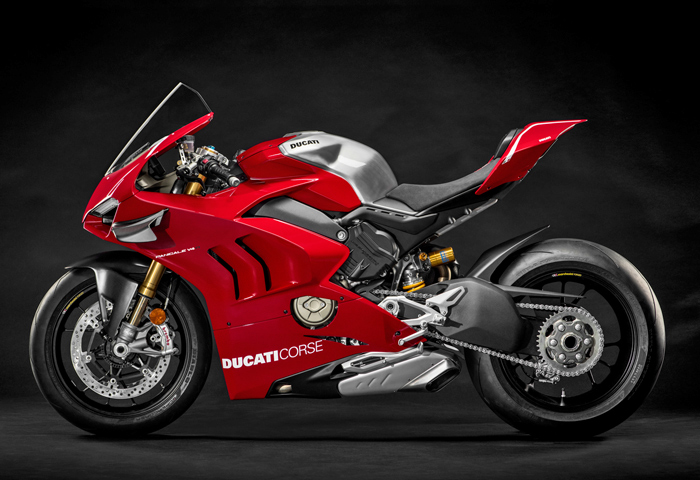 Above: The V4R19 street bike. Above: The V4R19 street bike.
The RS racebike also gets all different lightweight carbon fibre bodywork. Only the Ducati exclusive winglets look to be carried over from the production V4R. Plus there;s an entirely different fuel tank assembly, providing more space under the tan for the air box and electronics, and to help lower the center of gravity of the heavy fuel. You can see on the RS the bottom of the fuel tank now extends much lower under the seat along side of the rear shock reservoir.
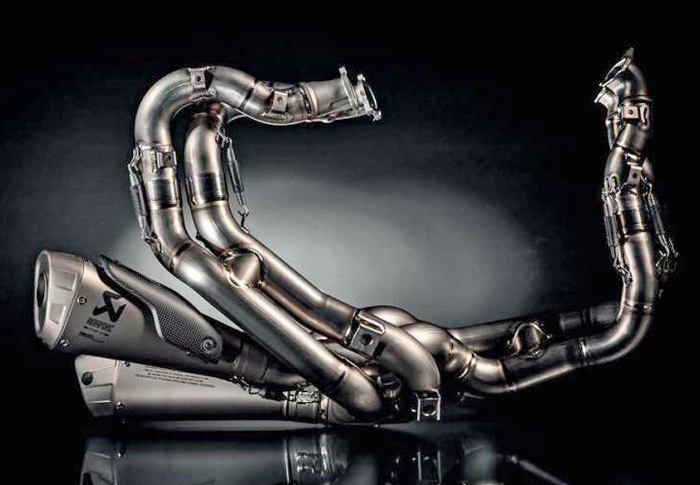
This is the full Akrapovic Titanium Racing Exhaust for all models of Panigale V4s. As a separate Ducati Performance part it is priced at $5100. With this exhaust the V4R's stock power output is raised from 221 hp (162 kW) of power at 15,250 rpm (EU homologation values) with the stock street exhaust to 234 hp (172 kW) at 15,500 rpm.
|
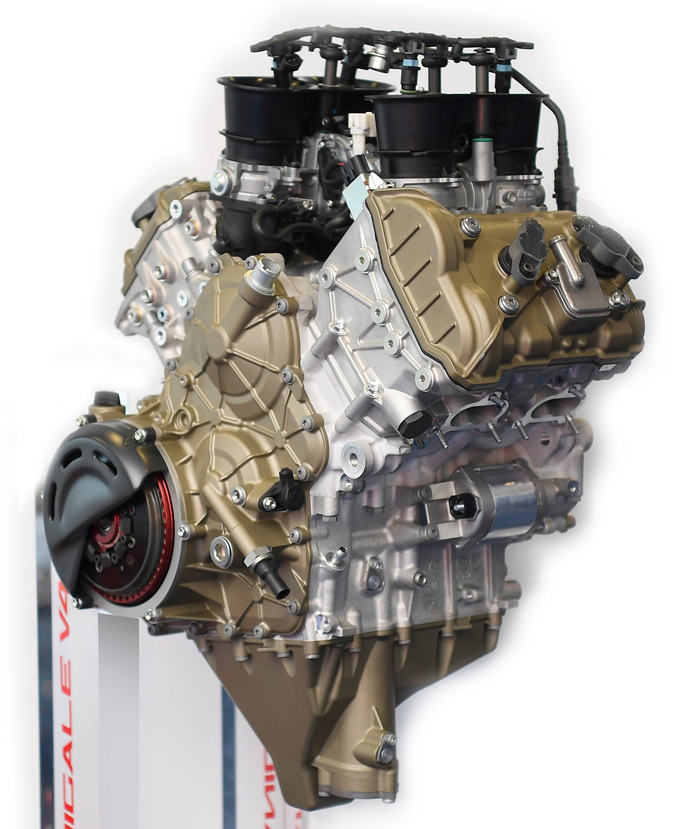
The Desmosedici Stradale R - the link between the 1,103 cm3 V4 on the Panigale V4 and the MotoGP engine - takes the performance limits for a road-legal engine to unprecedented heights. Originally designed to compete in the Superbike championships, this engine has now undergone numerous changes that make it even more like the one used in MotoGP.
The Panigale V4 R engine can deliver 221 hp (162 kW) at 15,250 rpm and 112 Nm of torque at 11,500 rpm (EU homologation values). It has a 14:1 compression ratio and the rev limiter is set at 16,000 rpm (16,500 rpm in sixth gear). These figures - impressive for a 998 cm3 engine - can be taken even higher by fitting the full-racing Ducati Performance exhaust by Akrapovič, which boosts maximum power to 234 hp (172 kW) at 15,500 rpm.
Like the Desmosedici Stradale, the R version is a 90° V4 with cylinders banked 42° back from the horizontal, a Twin Pulse firing order and a counter-rotating crankshaft*. Designed to be a fully stressed member of the vehicle, the engine retains a bore of 81 mm while stroke has been changed to 48.4 mm thanks to the new forged steel crankshaft which moves four titanium con rods with a centre-to-centre of 104.3 mm: each one is 100 g lighter than the steel ones used on the Panigale V4.
Pistons are made of moulded aluminium, have a single compression ring plus an oil ring and take advantage of “box in box” technology: this contains both skirt height and below-chamber thickness, helping to reduce attrition and inertial loads while maintaining the necessary strength and stiffness.
Featuring dedicated profiles, the four Desmosedici Stradale R camshafts provide increased lift with respect to the Desmosedici Stradale and move the sixteen valves (Ø 34 mm titanium intake valves, Ø 27.5 mm steel exhaust valves). The valves feature titanium half-cones, a solution usually adopted only on racing bikes. Dedicated fluid dynamic design of the R engine cylinder heads has led to the development of new, larger intake ducts.
The new crankshaft - 1,100 grams lighter than the one on the Panigale V4 - is mounted on brass bushings and retains the 70° crank pin offset together with the 90-degree V engine layout. This solution generates what Ducati calls a Twin Pulse firing order, because it's as if the engine were reproducing the firing sequence of a twin-cylinder. The distinctiveness lies in the fact that the two left-hand cylinders fire closely together, as do the two right-hand ones. On the timing chart, the ignition points are, then, at 0°, 90°, 290° and 380°. This particular firing order makes the V4 sound just like the MotoGP Desmosedici.
The Desmosedici Stradale R engine gulps in air through oval throttle bodies and aerodynamic throttle openings (Ø 56 mm equivalent, an increase of 4 mm) connected to variable-height air intake horns of dedicated length. This solution optimizes cylinder intake across the rev range, giving major advantages in terms of power delivery and handling. The R engine breathes through a high-permeability Sprintfilter P08 air filter.
Thanks to development in close collaboration with Ducati Corse, the R version of the Desmosedici Stradale engine has undergone numerous performance-enhancing improvements. To limit power absorption the oil delivery pump has been redesigned and the alternator rotor lightened, shaving another 100 grams off total bike weight.
* This layout demands the addition of the so-called 'jackshaft' to transfer crankshaft drive through the gearbox to the rear wheel so it turns the right way. The jackshaft adds an extra transmission element to the crankshaft-wheel connection system. This needs to be taken into consideration when establishing crankshaft power if the latter is obtained from measurements made at the wheel. During both homologation and measurement on acceleration test benches it is, therefore, necessary to consider an efficiency or, in any case, an additional coefficient that is, by law, fixed at 0.98.
Dry clutch
As in MotoGP, where all that matters is maximum performance, the Panigale V4 R features a dry clutch. The V4 R mounts an STM EVO-SBK clutch, made of machined-from-solid aluminium with a 48-tooth clutch basket and plate set; there are 9 take-up plates and 9 drive plates with a diameter of 138 mm.
During extreme on-track use, this gives greatly improved ride 'feel'. More specifically, the dry clutch ensures a more efficient anti-patter function, even during aggressive downshifting, and greater fluidity during 'off-throttle' phases; moreover, it's also possible to personalize the degree of 'mechanical' engine braking by selecting a different secondary spring from those available in the Ducati Performance accessories catalogue.
Further benefits include the absence of the resistance opposed by the engine oil and reduced oil contamination as dust from disc wear is not carried into the lubrication circuit.
Last but not least, there's the iconic mechanical clutch rumble which Ducati fans find irresistible.
Ducati V4R 998cc and V4 1100cc Main Technical Data:
• 998 cm³ 4-cylinder 90-degree V (Standard 1103 cm³ on the standard models)
• Bore x stroke 81 x 48.4 mm (Standard models Bore x stroke 81 x 53.5 mm)
• Compression ratio 14:1 Stock, WSBK RS N/A
• Maximum power 162 kW (221 hp) @ 15,250 rpm (exceeds 210 hp at 13,000 rpm on the Standard models)
• Maximum torque exceeds 112 Nm (83 lb-ft) @ 11,500 rpm (Standard Models 120 Nm from 8,750 to 12,250 rpm
• Counter-rotating crankshaft
• Twin Pulse firing sequence, crank pins offset at 70°
• Desmodromic part chain, part gear timing with dual overhead camshaft, 4 valves per cylinder
• Wet multiplate anti-patter servo clutch
• Semi-dry sump lubrication with four oil pumps: 1 delivery and 3 return
• Fuelling with four oval throttle bodies (52 mm diameter equivalent) and variable-height intake horns
• 6-speed gearbox with DQS up/down system
Click Here for > 2019 Panigale V4 and V4R Specification Sheet PDF <
Variable Intake System
The Desmosedici Stradale engine takes in air through four oval throttle bodies (52 mm diameter equivalent), connected to variable-height air intake horns, featured for the first time on a Ducati engine. This solution optimizes cylinder intake across the rev range, giving major advantages in terms of power delivery and handling.
As rpm and rider-requested power vary, the air intake horns take on a configuration that lengthens or shortens the ducts, optimizing the fluid dynamics of the pressure waves that run along the duct itself. Controlled by the ECU, the system consists of two stages: a fixed horn on the throttle body and a mobile one that is moved along steel guides by an electric motor. When the latter is lowered, it comes into contact with the short horn, geometrically lengthening the duct. When raised, the fluid dynamics involve only the fixed lower horn and the engine configuration is characterized by a very short duct.
Each throttle body has two injectors: a sub-butterfly one for low-load use and another above it that comes into play when maximum engine performance is required. The throttle bodies of each cylinder bank are moved by a dedicated electric motor. Thanks to the full Ride by Wire system, this allows complex electronic control strategies and modulation of engine 'feel' according to the selected riding mode.
Latest-generation Desmodromic system
As on all Ducati engines, the Desmosedici Stradale sees Desmodromic design playing a pivotal performance role. On the Desmosedici Stradale, the Desmodromic system uses fully redesigned, miniaturized components that have allowed for the construction of very small cylinder heads, achieving a degree of sophistication, lightness and compactness never before seen on a Ducati. Every single system component has been designed and tested to operate safely at the high revs the V4 is capable of. New spark plugs - smaller than standard models - also help keep the heads compact.
The four Desmosedici Stradale engine camshafts control the sixteen valves: valve diameters are 34 mm diameter on intakes and 27.5 mm on exhausts, values decidedly on the high side given the 81 mm bore. The valve seats are made of sintered steel.
Given the high revs attained by the V4 and the large valves, a traditional spring system would be inadequate because the valves would be unable to follow the steep cam profiles. This, then, is where the Desmodromic system becomes a must. With the "Desmo" system the valves are closed mechanically with the same level of accuracy as they're opened. This allows the steep cam profiles and radical cam timings that optimism intake and exhaust fluid dynamics to provide higher engine performance.
The camshafts are controlled by two “silent” timing chains. At the front, the chain drives the intake camshaft which, in turn, transmits drive to the exhaust camshaft via a pair of cogs (hybrid chain-cog timing). On rear timing, instead, the chain drives the exhaust camshaft, which transmits drive to the intake camshaft. This solution minimizes timing power absorption, enhancing performance and reliability. Front cylinder timing is controlled by the chain on the right-hand side of the engine, turned by the crankshaft via a gear obtained on the primary drive pinion. The one that controls rear cylinder timing is on the left-hand side of the engine and is driven by a monobloc gear on the crankshaft. Each cylinder head has an “anti-knocking” sensor that optimizes spark advance to prevent any combustion shock.
Semi Dry-Sump Oiling System
As on MotoGP engines, the Desmosedici Stradale uses semi-dry sump lubrication with delivery and return stages that ensure effective lubrication of all moving parts at all times.
The oil circulation system consists of four pumps: one delivery lobe pump and three recovery pumps. One of the latter, a gear pump, draws oil from the heads via two ducts while the other two lobe pumps ensure efficient oil recovery under all conditions, keeping the crankcase zone under the pistons in a controlled, constant low pressure state and thus reducing airing losses (i.e. power absorption caused by the aerodynamic resistance exerted by the air and splashing of the oil in the con rod casing).
The oil tank - which also acts as a filter housing - is in a magnesium sump mounted underneath the crankcase and connected to the gearbox
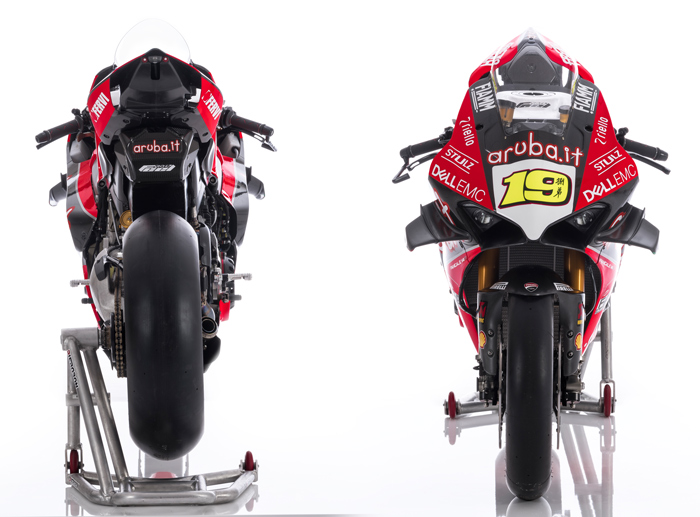
Return to: Ducati Index • New Bike Index • Pit Lane News • Calendar Bike Garage
|
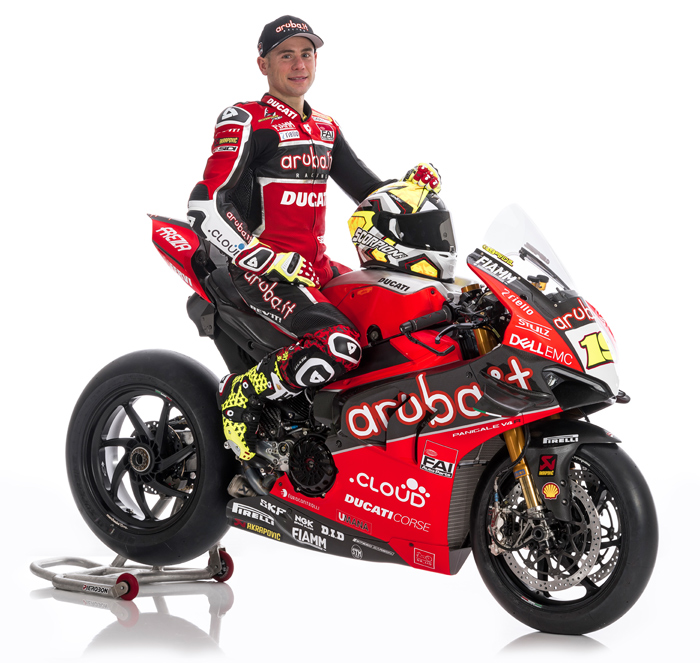 Álvaro Bautista (19) totally dominatd the first WSBK race of the 2019 seaso at Phillip Island, while normally competive team mate Chaz Davies struggled with bike setup in mid-pack. Álvaro Bautista (19) totally dominatd the first WSBK race of the 2019 seaso at Phillip Island, while normally competive team mate Chaz Davies struggled with bike setup in mid-pack.
Ducati premiered at EICMA 2018, both the 2019 production V4R (above), and the V4RS Corse (below) factory race bike for World Superbike, and for various National Championships were eligible. Differences on the V4RS seen in this picture include higher spec Ohlins MotoGP forks, higher spec Brembo front calipers and brake rotors, full carbon fibre bodywork, different Marchesini race wheels, a larger capacity furl tank extending down below the seat, a different rear aluminum rear sub frame with carbon fibre heat shields, and billet adjustable foot controls. It certainly has the WSBK spec ECU electronics as well. The only question is, will WSBK let the V4R/RS run at full production bike 234hp horsepower to beat the al dominate Jonthan Re Kawasaki ZX10R, or will they restrict it down to the 220hp limit of the other bikes? Keep in mind that the Stradale engine with its MotoGP derived design, could easily be tuned up to 280hp if allowed.
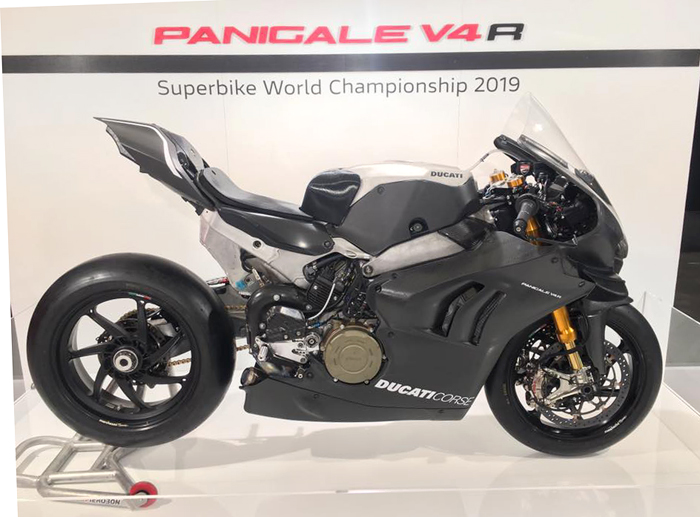
To contain the inevitable weight gain with respect to the 1299 Panigale (because of the 4 cylinders) Ducati has developed an all-new frame where the Desmosedici Stradale itself has a load-bearing function. Called Front Frame, it's more compact and lighter than a perimeter frame and uses the engine as a stressed chassis element. This solution ensures the right torsional rigidity for on-the-edge riding and gives riders outstanding "feel". The Front Frame has allowed the designer to create a bike that is slender in the tank-seat merge zone: this, together with seat/handlebar/footpeg triangulation, ensures perfect bike-rider integration. Together with meticulous design and the use of light materials, the new frame keeps the kerb weight of the S and Special versions down to 195 kg. This weight, combined with the 214 hp, means a power/weight ratio of 1.1 hp/kg, putting the Panigale V4 S at the top of the sport bike segment.
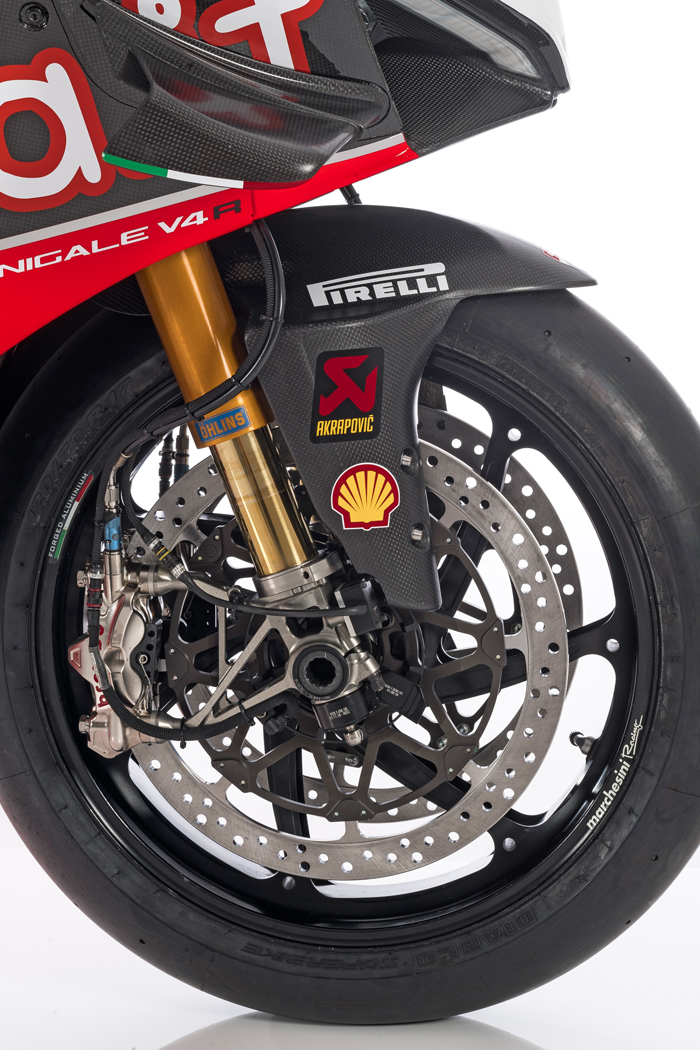
Higher spec Marchesini Race wheels with stronger double spoke webs and drilled lightening holes. Newer MotoGP spec Brembo monoblock brakes replace the already excellent Brembo monoblock production brakes. Multiple electronic sensors for anti-lock brakes, traction control and engine maping.
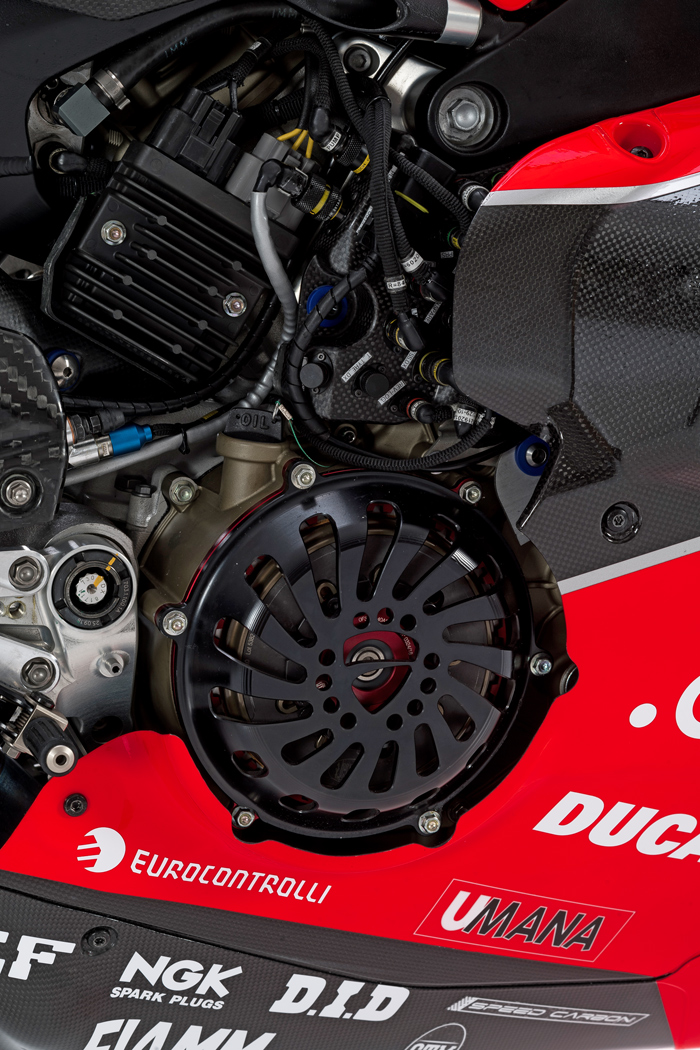
|
The production V4R comes with Ohlins mechanically adjustable front forks to comply with FIM race rules outlawing electronic suspensions, but the RSV4RS Corse bike gets even higher spec Ohlins Superbike race forks priced capped at USD $10,000.
Below, the V4RS naked an exposed.
Return to: Ducati Index • New Bike Index • Pit Lane News • Calendar Bike Garage
|



 Above: The V4RS19 has a different swingarm, and a fuel tank extending lower beside the rear shock.
Above: The V4RS19 has a different swingarm, and a fuel tank extending lower beside the rear shock.







